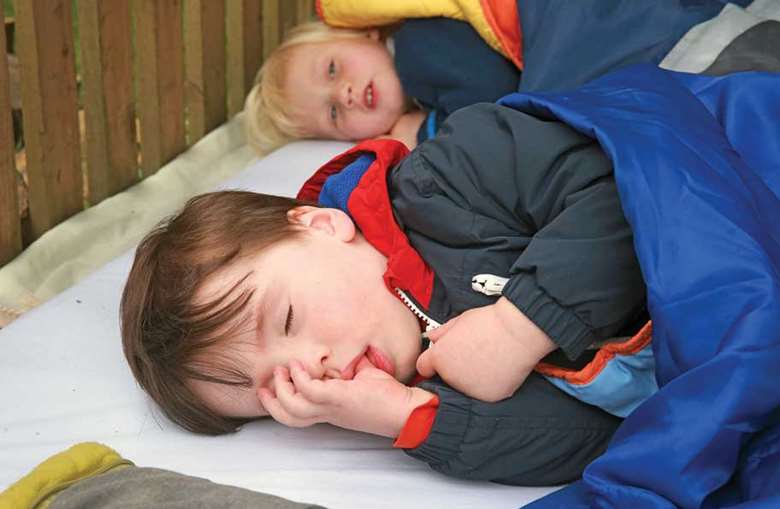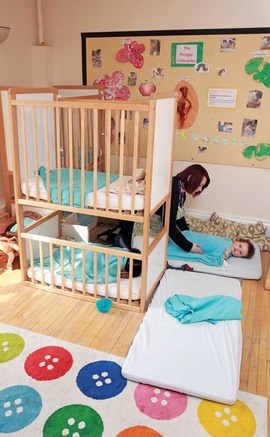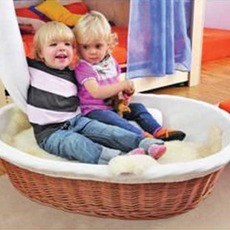Nursery Equipment: Sleep Time - Zzzzz...
Katy Morton
Monday, May 19, 2014
Whether sleeping indoors or outside, the key is to cater to every child's needs, writes Katy Morton.

Providing a sleep-friendly environment that considers the needs of the individual child is an essential part of a nursery's practice. Early years settings have a vital role to play in ensuring babies and toddlers get their daily quota of sleep, which is essential for their wellbeing and development.
This is recognised at ABC Day Nursery in Tallington, Lincolnshire, which has adopted a flexible approach to babies' and toddlers' sleeping arrangements. Owner Tracy Neal explains, 'We take the lead from parents when it comes to their child's sleeping arrangements. They can choose whether they would like their child to sleep, for example, in a cot, bed or on a mat.'
Along with a separate sleep room, the nursery also has a quiet area in each room where children can go to for a rest or sleep when they want to.
The quiet areas, which Ms Neal says are most popular with toddlers, are equipped with beanbags, small quilts and cushions. She is also looking at introducing 'baby nests' to the setting for its sixto 18-month-olds, which she hopes the children will learn to go to themselves when they become tired.
CHILDREN TAKE THE LEAD
At Childfirst Day Nursery in Moulton, Northamptonshire, children get the opportunity to sleep inside and out.
'We've found that the older children show more of an interest in sleeping outside than in,' says nursery manager Angela Green. 'The toddlers sleep in warm sleeping bags on top of mattresses in our outdoor sleep room from Dragons Wood, which looks a little like a bandstand, providing shelter and shade from the elements.
'They sleep outside in all temperatures, apart from in extreme weather, as well as eating outside.'
The nursery's youngest children, who require more rest, sleep inside the setting on BunkCots (see Best Buys).
'We chose the BunkCots as they have an enclosed top bunk for babies, while the bottom bunk has an open side, which means older children who are able can assist their own sleeping,' says Ms Green.
'When the weather is nice, we take the cots outside.'
AGE APPROPRIATE
Farley Nursery Schools, which has an 'outdoor learning ethos', provides a sleep-friendly environment to suit a wide range of ages.
Babies at the setting in Farley, Wiltshire, sleep in coach-built prams, some of which, according to owner Sue Palmer, are 30 years old and have hoods made from silk.
'The babies are swaddled in blankets and wear woollen hoods. They sleep under an awning which protects them from rain, heavy winds and snow,' says Ms Palmer, who believes that the children sleep better in the fresh air.
'While our babies sleep in the garden, children over the age of two take naps indoors because of noise and space reasons.'
The nursery, explains Ms Palmer, had been faced with the challenge of finding somewhere the children wouldn't be disturbed, as they found that the older children, who don't take naps, tended to keep them awake outside. Currently, the over-twos sleep on mattresses inside the setting. However, the Farley nursery has recently bought a 6m yurt, which Ms Palmer says they are considering as an option for the children to sleep in. In the winter months, a wood-burning stove would be used inside the yurt to keep the children warm.
She is also intending to introduce a yurt to Farley's other Wiltshire setting, in Steeple Langford, next year. That would follow this summer's opening of the group's new nursery in Sparshot, Hampshire, which will be the country's first 'yurt-based outdoor nursery'.
'Within the new setting will be a Dream Yurt,' says Ms Palmer. 'There won't be enough room for the coach-built prams, so children will sleep on wooden coracle beds.'
Ms Palmer says the idea for the yurts was inspired by the teepee their storyteller brings to the settings in the summer.
'The children love sitting in the teepee and listening to stories. However, teepees aren't weatherproof or waterproof, so we turned our focus to yurts,' explains Ms Palmer, who says that yurts are designed to withstand the wind and cold.
EXPERT ADVICE
Early years consultant Julia Manning-Morton recommends that early years practitioners discuss with the parents what their child's sleeping arrangements are at home.
She says it is very likely that children will have to adapt to sleeping on something new at nursery, because not many will sleep on mats or in 'nests' at home.
'Early years settings should think about how to ease children into making this transition,' advises Ms Manning-Morton. 'They could ask parents to bring in blankets from home, which have a familiar smell, or photos of their family to put by their cot/bed at nursery to comfort them.'

She also advises nurseries 'to plan around the child'.
'Practitioners shouldn't expect children to sleep or not sleep. At the same time, they should not force babies or toddlers to sleep or stay awake,' she says. 'This can sometimes conflict with parents' wishes - for instance, if a parent has said their child sleeps at a certain time for so many hours, but for some reason this does not happen on a given day.
'This is why settings must develop strong relationships with parents as children's sleep can fluctuate,' Ms Manning-Morton explains.
BEST BUYS
- The Original BunkCot, £429, thebunkcot.com
- Dream Coracle, £250, www.communityplaythings.co.uk
- Quilted mats, from £18.80, www.wesco-eshop.co.uk
- Timber garden buildings, www.dragonswood.co.uk
- Cot, £250; folding cot, £280, www.earlyyearsdirect.com
- Snuggle and Sleep Basket, £70.20; Sheepskin Rug, £69.70, www.ascoeducational.co.uk (above)
- Wooden Evacuation Cot and Mattress, £249.95, www.hope-education.co.uk
SLEEPING ARRANGEMENTS: THE DOS AND DON'TS
Early years consultant Penny Tassoni provides guidance for early years settings on what they should and shouldn't be doing when it comes to children's sleep and nap times.
Do
- Work closely with parents
- Make parents aware of the importance of a nap for their children
- Set a sleep routine - it is good for children to sleep at the same time every day
- Install a sleep habit
- Work towards children self-settling - this is the 'Holy Grail'
- Use any sleep equipment that works for you
- Be aware that if you are using 'baby nests', a child who wakes up will have access to other children
Don't
- Make any changes to a child's sleep routine, for instance the equipment in which they sleep
- Let toddlers fall asleep for long periods of time - more than 30 minutes - in a pushchair because this is bad for their backs. Babies and toddlers should sleep flat on their backs
- Introduce any routines that stop self-settling, such as rocking a child to sleep, because they will then always expect and need this to fall asleep.
Photos at Childfirst Day Nursery, Northamptonshire by Tony Hardacre




